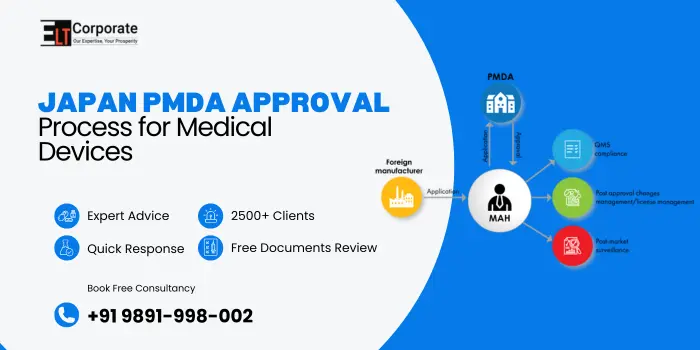Japan PMDA approval process (Pharmaceuticals and Medical Devices Agency), under the Ministry of Health, Labour and Welfare (MHLW). The PMDA reviews, approves, and monitors medical devices to ensure they are safe, effective, and of high quality. Suppose you want to sell a medical device in Japan. In that case, you must navigate PMDA’s regulatory process, which depends on the device’s risk class, whether it is new or equivalent to already approved devices, and whether you need clinical data. Below, we explain how that works.
What is the PMDA and its role in Medical Devices?
- The PMDA is the Japanese regulatory body responsible for reviewing medical device and pharmaceutical applications.
- For medical devices, it assesses safety, performance, clinical data (where needed), and ensures compliance with Japan’s laws (the PMD Act).
- PMDA also performs site inspections, audits, and monitors post-market surveillance.
How are Medical Devices Classified in Japan?
Japan uses a risk classification system similar to many other countries. Devices are classed by risk (e.g., lower risk vs higher risk), which determines how stringent the review process must be. Lower risk devices may require only notification (called “Todokede” in Japanese) rather than full review, while moderate to high risk devices must go through the full Shonin (approval) pathway.
What is the Shonin (Pre-Market Approval) Pathway?
The Shonin pathway is the formal approval path for devices that require full evaluation by PMDA before being marketed in Japan.
Key steps include:
- Preparing technical documentation (design, performance data, risk analysis, equivalence, clinical data if needed).
- Appointing a Marketing Authorisation Holder (MAH) in Japan to be responsible for the device in the Japanese market (foreign firms need a local MAH).
- Applying (often in Japanese, though PMDA now allows some documents in English under conditions).
- PMDA review, including expert discussion and possible requests for additional data.
- If accepted, issuance of approval and listing in the Japanese market.
How does Japan treat “Generic” or Equivalent Devices?
Japan allows a “generic device” pathway for devices that are substantially equivalent to already approved devices. In such cases, clinical data may not always be required, making the process simpler.
Are there Expedited or Conditional Approval Routes in Japan?
Yes. PMDA has introduced fast-track pathways such as the Conditional Early Approval System (for certain innovative medical devices) and Sakigake designation (for breakthrough devices) to accelerate access. These allow devices to be marketed earlier under oversight, with post-market data required.
What is the Review Process and Timeline?
- The process typically includes PMDA consultation, technical review, expert evaluation, possible inspections, and final decision.
- The timeline varies by risk class and complexity. It can take 6 months to several years (especially for novel high-risk devices).
- Fees are significant; cost depends on device class, novelty, and whether clinical trials are needed.
Required Documents and Data for Japan PMDA Approval Process for Medical Devices Submission
Typical documents include:
- Device description and intended use
- Design drawings, specifications, software architecture
- Risk analysis and mitigation
- Performance test data (bench, electrical safety, biocompatibility)
- Clinical data (if required)
- Manufacturing site quality systems and processes
- Labeling, instructions for use
- Equivalence data for generics
- Translated documents in Japanese (or English under certain conditions)
Are Inspections or Audits Part of the Process?
Yes. PMDA or authorized bodies may inspect manufacturing facilities or conduct audits to confirm compliance with quality systems, manufacturing controls and consistency.
How Does Post-Market Surveillance Work in Japan?
After a device is approved, the manufacturer/MAH must monitor safety, report adverse events, possibly conduct post-market studies, and provide updates to PMDA if new risks emerge.
What is the Cost of PMDA Approval?
Costs depend on the classification (Class I, II, III, IV) and whether the device is new or generic. Some example fees: for brand-new class IV devices, cost is very high; for generics, lower.
Can Submissions be done in English?
Yes. In recent years, PMDA has started allowing parts of the submission (e.g. Common Technical Document) to be in English under certain conditions.
What Challenges do Foreign Manufacturers Face?
- Need for a local Marketing Authorisation Holder (MAH)
- Japanese translation and local regulatory knowledge
- Complex clinical and equivalence data requirements
- Long review timelines and high costs
- Matching Japan’s regulatory expectations, which may differ from other markets
How has PMDA Improved its Review Efficiency?
- Introduction of fast-track and conditional approval paths (Sakigake, early approval) for innovative devices.
- Setting target review timelines and increasing staffing.
- Allowing English submissions to ease global access.
Is Clinical Trial Data Always Required for PMDA Device Approval?
No, it depends on device risk, novelty, and equivalence; some lower-risk or equivalent devices may not require new clinical trials.
Do Foreign Manufacturers need a Japanese agent for PMDA Submissions?
Yes, foreign firms must appoint a local Marketing Authorisation Holder (MAH) to act in Japan.


Comments are closed